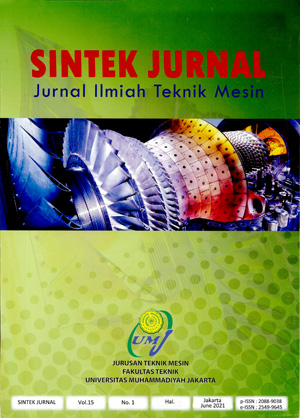DESIGN OF FINISHED GOODS INSPECTION ACCELERATION WITH QCC METHOD AND SEVEN TOOLS TO INCREASE PRODUCTIVITY
Main Article Content
Abstract
Article Details
- Articles published in SINTEK JURNAL are licensed under a Creative Commons Attribution-ShareAlike 4.0 International license. You are free to copy, transform, or redistribute articles for any lawful purpose in any medium, provided you give appropriate credit to the original author(s) and SINTEK JURNAL, link to the license, indicate if changes were made, and redistribute any derivative work under the same license.
- Copyright on articles is retained by the respective author(s), without restrictions. A non-exclusive license is granted to SINTEK JURNAL to publish the article and identify itself as its original publisher, along with the commercial right to include the article in a hardcopy issue for sale to libraries and individuals.
- By publishing in SINTEK JURNAL, authors grant any third party the right to use their article to the extent provided by the Creative Commons Attribution-ShareAlike 4.0 International license.
References
S. Bastuti, “Analisis Kegagalan Pada Seksi Marking Untuk Menurunkan Klaim Internal Dengan Mengaplikasikan Metode Plan–Do–Check–Action (PDCA),” J. SINTEK, vol. 11, no. 2, pp. 113–122, 2017.
M. G. Putra et al., “Issn : 2337 - 4349,” pp. 222–230, 2017.
B. Aprina, “ANALISA OVERALL RESOURCE EFFECTIVENESS UNTUK MENINGKATKAN DAYA SAING DAN OPERATIONAL EXCELLENCE Pasar konstruksi dan sektor bahan bangunan Indonesia telah berkembang secara signifikan , didorong oleh pesatnya,” JITMI (Jurnal Ilm. Tek. dan Manaj. Ind., vol. 2, 2019.
P. Golder and D. Mitra, Product Design and Development. 2018.
A. R. W, “Perancangan Peningkatan Optimalisasi Produksi Dengan Pendekatan Function Analisys System Technique ( Fast ) Pada Desain Produk Industri Kran Wastafel,” Jitmi, vol. 1, no. 2, 2018.
M. Tlanusta Garret, L. D. Borders, L. B. Cruchfield, E. Torres-Rivera, D. Brotherton, and R. Curtis, “Copyright ©2001. All Rights Reserved.,” J. Multicult. Couns. Devel., vol. 29, pp. 147–158, 2001.
A. A. Saripudin and M. Satar, “Analisa PSaripudin, A. A., & Satar, M. (2014). Analisa Pengendalian Kualitas Produk Bracket Electric Air Bus 380 Dengan Metode Six Sigma Pada Area Profile Press Forming di PT X. Indept, Vol. 4, pp. 25–37.engendalian Kualitas Produk Bracket Electric Air Bu,” Indept, vol. 4, no. 3. pp. 25–37, 2014.
Ratnadi and E. Suprianto, “Pengendalian Kualitas Produksi Menggunakan Alat Bantu Statistik (Seven Tools) Dalam Upaya Menekan Tingkat Kerusakan Produk,” Indept, vol. 6, no. 2, pp. 10–18, 2016.
R. Alfatiyah, S. Bastuti, and D. Kurnia, “Implementation of statistical quality control to reduce defects in Mabell Nugget products (case study at Pt. Petra Sejahtera Abadi),” IOP Conf. Ser. Mater. Sci. Eng., vol. 852, no. 1, 2020, doi: 10.1088/1757-899X/852/1/012107.
P. Wisnubroto and A. Rukmana, “Pengendalian Kualitas Produk Dengan Pendekatan Six Sigma Dan Analisis Kaizen Serta New Seven Tools Sebagai Usaha Pengurangan Kecacatan Produk,” J. Teknol., vol. 8, no. 8, pp. 65–74, 2015.
T. Windarti, “Pengendalian Kualitas Untuk Meminimasi Produk Cacat Pada Proses Produksi Besi Beton,” J@Ti Undip J. Tek. Ind., vol. 9, no. 3, pp. 173–180, 2014, doi: 10.12777/jati.9.3.173-180.
A. Faritsy Al Zaqi and Suseno, “Peningkatan produktivitas perusahaan dengan menggunakan metode,” J. Tek. Ind., vol. 10, no. 2, pp. 103–116, 2015.
R. Alfatiyah, “Analisis Kualitas Jasa Periklanan Dengan Kombinasi Metode Servqual Dan Quality Function Deployment (Qfd) Untuk Meningkatkan Kepuasan Pelanggan,” JITMI (Jurnal Ilm. Tek. dan Manaj. Ind., vol. 1, no. 1, pp. 1–7, 2018.
R. Ruspendi, “Strategi Keunggulan Bersaing Industri Retail Komponen Otomotif Dalam Upaya Meningkatkan Kinerja Di Pt. Astra Otoparts Tbk,” JITMI (Jurnal Ilm. Tek. dan Manaj. Ind., vol. 2, no. 1, p. 18, 2019, doi: 10.32493/jitmi.v2i1.y2019.p18-26.
F. Taroni, S. Bozza, A. Biedermann, P. Garbolino, and C. Aitken, Data Analysis in Forensic Science: A Bayesian Decision Perspective. 2010.


